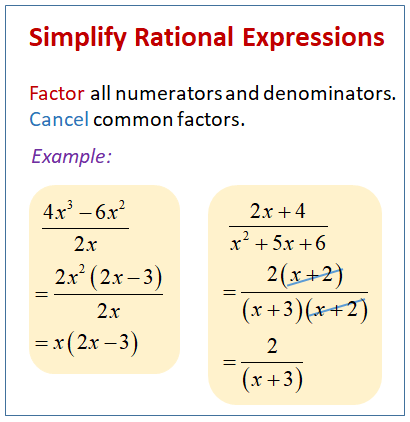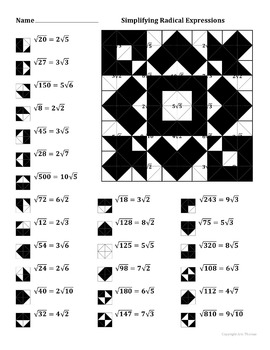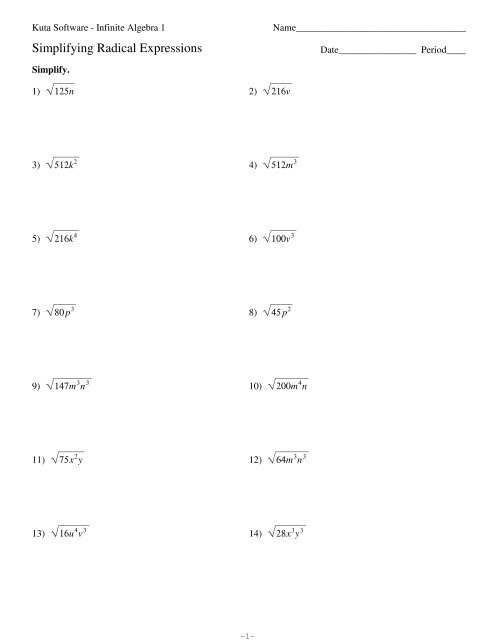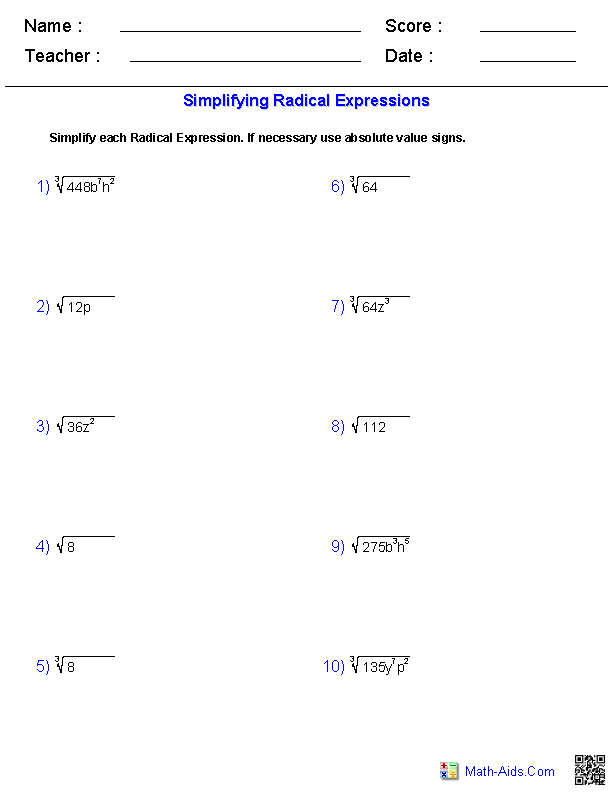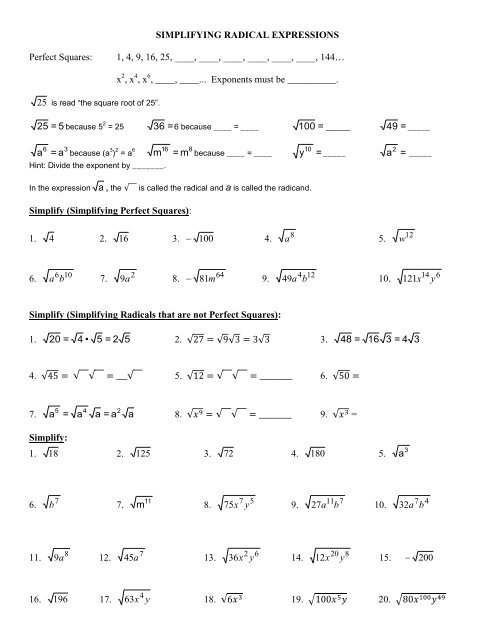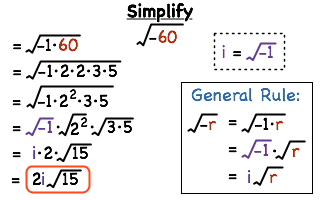Topic examples of simplifying radical expressions: Discover how to simplify radical expressions with our comprehensive guide. Learn step-by-step methods, including prime factorization and the quotient rule, to make complex calculations easy and accurate. Perfect for students and math enthusiasts looking to enhance their skills and confidence in handling radicals.
Table of Content
- Examples of Simplifying Radical Expressions
- Introduction to Radical Expressions
- Basic Concepts of Radicals
- Prime Factorization Method
- Simplifying Radicals with Perfect Squares
- Radicals with Variables
- Product Rule for Radicals
- Simplifying Higher-Order Roots
- Examples and Practice Problems
- Common Mistakes to Avoid
- Applications of Radical Expressions
- Conclusion
- YOUTUBE: Video này hướng dẫn cách đơn giản hóa biểu thức với biến, số mũ, phân số và căn bậc ba trong đại số.
Examples of Simplifying Radical Expressions
Simplifying radical expressions involves reducing the expression to its simplest form. Here are several methods and examples to guide you through the process.
Using Prime Factorization
The prime factorization method involves breaking down the number under the radical into its prime factors. Let's see how it works with an example:
- Example: Simplify \( \sqrt{72} \)
- Step 1: Find the prime factors of 72: \( 72 = 2^3 \times 3^2 \)
- Step 2: Group the prime factors in pairs: \( 2^3 = 2^2 \times 2 \) and \( 3^2 = 3 \times 3 \)
- Step 3: Simplify inside the radical: \( \sqrt{72} = \sqrt{2^2 \times 3^2 \times 2} = 2 \times 3 \times \sqrt{2} = 6\sqrt{2} \)
Using the Quotient Rule
The quotient rule for radicals states that the square root of a quotient is the quotient of the square roots. Here's an example:
- Example: Simplify \( \sqrt{\frac{50}{2}} \)
- Step 1: Simplify the fraction inside the radical: \( \frac{50}{2} = 25 \)
- Step 2: Apply the square root: \( \sqrt{25} = 5 \)
Simplifying Radical Expressions with Variables
When simplifying radical expressions with variables, apply the same rules as you would with numbers. Consider the following example:
- Example: Simplify \( \sqrt{50x^2} \)
- Step 1: Factor the expression inside the radical: \( 50x^2 = 25 \times 2 \times x^2 \)
- Step 2: Simplify inside the radical: \( \sqrt{25 \times 2 \times x^2} = \sqrt{25} \times \sqrt{2} \times \sqrt{x^2} \)
- Step 3: Apply the square root: \( 5 \times \sqrt{2} \times x = 5x\sqrt{2} \)
Using the Product Rule
The product rule for radicals states that the square root of a product is the product of the square roots. Here's how to apply it:
- Example: Simplify \( \sqrt{18 \times 2} \)
- Step 1: Apply the product rule: \( \sqrt{18 \times 2} = \sqrt{18} \times \sqrt{2} \)
- Step 2: Simplify each radical: \( \sqrt{18} = 3\sqrt{2} \)
- Step 3: Combine the results: \( 3\sqrt{2} \times \sqrt{2} = 3 \times 2 = 6 \)
Rationalizing the Denominator
Rationalizing the denominator involves eliminating the radical from the denominator of a fraction. Here's an example:
- Example: Simplify \( \frac{5}{\sqrt{3}} \)
- Step 1: Multiply the numerator and the denominator by \( \sqrt{3} \): \( \frac{5}{\sqrt{3}} \times \frac{\sqrt{3}}{\sqrt{3}} = \frac{5\sqrt{3}}{3} \)
- Step 2: Simplify the expression: \( \frac{5\sqrt{3}}{3} \)
Combining Like Radicals
Combining like radicals is similar to combining like terms in algebra. Here's an example:
- Example: Simplify \( 2\sqrt{5} + 3\sqrt{5} \)
- Step 1: Identify like radicals: \( 2\sqrt{5} \) and \( 3\sqrt{5} \)
- Step 2: Combine the coefficients: \( 2 + 3 = 5 \)
- Step 3: Write the simplified expression: \( 5\sqrt{5} \)
By practicing these methods, you will become proficient at simplifying radical expressions, making complex calculations easier to handle.

READ MORE:
Introduction to Radical Expressions
Radical expressions involve roots, such as square roots or cube roots, of numbers and variables. Simplifying these expressions makes them easier to work with in mathematical calculations. This section will introduce the basic concepts and terminology associated with radical expressions, providing a solid foundation for more advanced topics.
Here are some key points to understand about radical expressions:
- A radical expression contains a radical symbol (√) with an expression inside it.
- The number inside the radical symbol is called the radicand.
- The most common radical is the square root, but higher-order roots, such as cube roots, also exist.
Let's break down the components of a radical expression with an example:
- Example: \( \sqrt{50} \)
- \( \sqrt{} \) is the radical symbol.
- 50 is the radicand.
Radical expressions can often be simplified to make them easier to handle. Simplifying involves finding an equivalent expression that has a simpler form. Here are some basic steps to simplify radical expressions:
- Identify and factor the radicand into its prime factors.
- Group the prime factors into pairs (for square roots) or triples (for cube roots).
- Rewrite the expression using these groups to simplify the radical.
Understanding these fundamental concepts will help you master the simplification of radical expressions. In the following sections, we will explore various methods and examples to further enhance your skills.
Basic Concepts of Radicals
Radicals are mathematical expressions that involve roots, such as square roots, cube roots, and higher-order roots. Understanding the basic concepts of radicals is essential for simplifying and manipulating these expressions effectively.
Here are the fundamental concepts related to radicals:
- Radical Symbol: The radical symbol (√) denotes the root of a number. For example, \( \sqrt{9} \) represents the square root of 9.
- Radicand: The number or expression inside the radical symbol is called the radicand. In \( \sqrt{9} \), the radicand is 9.
- Index: The index of a radical indicates the degree of the root. If no index is shown, it is assumed to be 2 (square root). For example, \( \sqrt[3]{8} \) represents the cube root of 8, where the index is 3.
Radicals can be simplified by following specific steps:
- Factor the Radicand: Break down the radicand into its prime factors.
- Example: \( \sqrt{50} \)
- 50 can be factored into \( 2 \times 5^2 \)
- Example: \( \sqrt{50} \)
- Group the Factors: Group the factors according to the index of the radical.
- For square roots, group into pairs: \( \sqrt{2 \times 5^2} \)
- Simplify the Radical: Take the root of the grouped factors and simplify.
- Example: \( \sqrt{2 \times 5^2} = 5\sqrt{2} \)
Here are some additional properties of radicals to keep in mind:
- Product Rule: \( \sqrt{a \times b} = \sqrt{a} \times \sqrt{b} \)
- Quotient Rule: \( \sqrt{\frac{a}{b}} = \frac{\sqrt{a}}{\sqrt{b}} \) where \( b \neq 0 \)
- Power Rule: \( (\sqrt{a})^n = a^{n/2} \)
Understanding these basic concepts and properties of radicals will provide a strong foundation for simplifying more complex radical expressions. In the upcoming sections, we will delve deeper into various methods and examples to master this topic.
Prime Factorization Method
The Prime Factorization Method is a straightforward and effective technique for simplifying radical expressions. This method involves breaking down the radicand into its prime factors and then simplifying the radical based on these factors. Here’s a detailed, step-by-step guide to using the Prime Factorization Method:
- Identify the Radicand: Determine the number or expression inside the radical.
- Example: \( \sqrt{72} \)
- Factor the Radicand into Prime Numbers: Break down the radicand into its prime factors.
- 72 can be factored into \( 2^3 \times 3^2 \)
- Group the Prime Factors: Group the prime factors in pairs (for square roots), triples (for cube roots), etc., depending on the radical's index.
- For \( \sqrt{72} \): \( 2^3 \) can be written as \( 2^2 \times 2 \) and \( 3^2 \)
- Simplify the Radical: Simplify by taking the root of the grouped factors and moving them outside the radical.
- \( \sqrt{72} = \sqrt{2^2 \times 2 \times 3^2} = 2 \times 3 \times \sqrt{2} = 6\sqrt{2} \)
Let’s look at another example to solidify our understanding:
- Example: \( \sqrt{180} \)
- Step 1: Factor the radicand: \( 180 = 2^2 \times 3^2 \times 5 \)
- Step 2: Group the factors: \( \sqrt{2^2 \times 3^2 \times 5} \)
- Step 3: Simplify: \( \sqrt{2^2} \times \sqrt{3^2} \times \sqrt{5} = 2 \times 3 \times \sqrt{5} = 6\sqrt{5} \)
The Prime Factorization Method can also be applied to radical expressions involving variables:
- Example: \( \sqrt{50x^2y^3} \)
- Step 1: Factor the radicand: \( 50 = 2 \times 5^2 \), so \( 50x^2y^3 = 2 \times 5^2 \times x^2 \times y^2 \times y \)
- Step 2: Group the factors: \( \sqrt{2 \times 5^2 \times x^2 \times y^2 \times y} \)
- Step 3: Simplify: \( 5xy \sqrt{2y} \)
By mastering the Prime Factorization Method, you can simplify a wide range of radical expressions, making them easier to work with in mathematical calculations.
Simplifying Radicals with Perfect Squares
Simplifying radicals with perfect squares is a fundamental skill in algebra. By identifying and extracting perfect square factors, you can simplify the expression to its simplest form. Here's how you can do it:
-
Identify the perfect square factors: Break down the number under the radical sign into its prime factors and identify the perfect square factors.
For example, to simplify \(\sqrt{72}\):
- Prime factorization of 72: \(72 = 2^3 \times 3^2\)
- Identify the perfect squares: \(2^2 = 4\) and \(3^2 = 9\)
-
Rewrite the radical: Rewrite the radical expression by separating the perfect square factors from the non-perfect square factors.
\(\sqrt{72} = \sqrt{2^3 \times 3^2} = \sqrt{(2^2 \times 3^2) \times 2} = \sqrt{36 \times 2}\)
-
Extract the perfect squares: Simplify by taking the square root of the perfect square factors and leaving the remaining factors under the radical.
\(\sqrt{36 \times 2} = \sqrt{36} \times \sqrt{2} = 6\sqrt{2}\)
-
Simplify the expression: Combine the simplified terms to get the final simplified radical expression.
The simplified form of \(\sqrt{72}\) is \(6\sqrt{2}\).
Let's look at another example:
-
Simplifying \(\sqrt{50}\):
- Prime factorization of 50: \(50 = 2 \times 5^2\)
- Identify the perfect squares: \(5^2 = 25\)
- Rewrite the radical: \(\sqrt{50} = \sqrt{2 \times 5^2} = \sqrt{25 \times 2}\)
- Extract the perfect squares: \(\sqrt{25 \times 2} = \sqrt{25} \times \sqrt{2} = 5\sqrt{2}\)
- Simplify the expression: The simplified form of \(\sqrt{50}\) is \(5\sqrt{2}\).
By practicing these steps, you can easily simplify any radical expression involving perfect squares. This technique is crucial for solving more complex algebraic problems and will enhance your overall mathematical proficiency.

Radicals with Variables
Simplifying radical expressions that contain variables follows similar rules to those with numerical values. Here, we'll go through the step-by-step process of simplifying such expressions.
Example 1: Simplifying \(\sqrt{x^4 y^3}\)
- Factor the expression under the radical:
\(\sqrt{x^4 y^3} = \sqrt{x^4 \cdot y^2 \cdot y}\)
- Apply the product rule for radicals:
\(\sqrt{x^4} \cdot \sqrt{y^2} \cdot \sqrt{y}\)
- Simplify each radical:
\(x^2 \cdot y \cdot \sqrt{y}\)
Example 2: Simplifying \(\sqrt[3]{8y^6}\)
- Factor the expression under the radical:
\(\sqrt[3]{8y^6} = \sqrt[3]{2^3 \cdot (y^2)^3}\)
- Apply the product rule for radicals:
\(\sqrt[3]{2^3} \cdot \sqrt[3]{(y^2)^3}\)
- Simplify each radical:
\(2 \cdot y^2\)
Example 3: Simplifying \(\sqrt{4a^5b^6}\)
- Factor the expression under the radical:
\(\sqrt{4a^5b^6} = \sqrt{2^2 \cdot a^4 \cdot a \cdot b^6}\)
- Apply the product rule for radicals:
\(\sqrt{2^2} \cdot \sqrt{a^4} \cdot \sqrt{a} \cdot \sqrt{b^6}\)
- Simplify each radical:
\(2 \cdot a^2 \cdot \sqrt{a} \cdot b^3\)
- Combine the simplified parts:
\(2a^2b^3\sqrt{a}\)
General Tips for Simplifying Radicals with Variables
- Always factor the expression completely to identify squares or cubes.
- Apply the product and quotient rules for radicals as necessary.
- Remember to include absolute values when the variables can represent negative numbers, especially when dealing with even roots.
Product Rule for Radicals
The product rule for radicals states that for any non-negative numbers \(a\) and \(b\), the square root of their product is equal to the product of their square roots:
\[
\sqrt{a \cdot b} = \sqrt{a} \cdot \sqrt{b}
\]
We can extend this rule to other roots, such as cube roots:
\[
\sqrt[3]{a \cdot b} = \sqrt[3]{a} \cdot \sqrt[3]{b}
\]
Here are some examples to illustrate the product rule for radicals:
- Example 1: Simplify \(\sqrt{50}\)
- Find the factors of 50: \(50 = 25 \cdot 2\)
- Use the product rule: \(\sqrt{50} = \sqrt{25 \cdot 2} = \sqrt{25} \cdot \sqrt{2}\)
- Simplify the square roots: \(\sqrt{25} = 5\) and \(\sqrt{2}\) remains the same.
- Combine the results: \(5 \cdot \sqrt{2}\)
So, \(\sqrt{50} = 5\sqrt{2}\)
- Example 2: Simplify \(\sqrt[3]{24}\)
- Find the factors of 24: \(24 = 8 \cdot 3\)
- Use the product rule: \(\sqrt[3]{24} = \sqrt[3]{8 \cdot 3} = \sqrt[3]{8} \cdot \sqrt[3]{3}\)
- Simplify the cube roots: \(\sqrt[3]{8} = 2\) and \(\sqrt[3]{3}\) remains the same.
- Combine the results: \(2 \cdot \sqrt[3]{3}\)
So, \(\sqrt[3]{24} = 2\sqrt[3]{3}\)
When working with variables, the product rule still applies. For example:
- Example 3: Simplify \(\sqrt{x^2 \cdot y}\)
- Use the product rule: \(\sqrt{x^2 \cdot y} = \sqrt{x^2} \cdot \sqrt{y}\)
- Simplify the square root of \(x^2\): \(\sqrt{x^2} = x\)
- Combine the results: \(x \cdot \sqrt{y}\)
So, \(\sqrt{x^2 \cdot y} = x\sqrt{y}\)
The product rule for radicals can simplify many complex radical expressions by breaking them down into more manageable parts. Always look for perfect square (or cube) factors within the radicand to simplify the expression efficiently.
Simplifying Higher-Order Roots
Higher-order roots, such as cube roots or fourth roots, follow similar principles to square roots but require careful consideration of the index. Here are some steps to simplify higher-order roots:
Step-by-Step Process
-
Identify the index of the root. For example, the cube root of \(a\) is written as \(\sqrt[3]{a}\), and the fourth root is written as \(\sqrt[4]{a}\).
-
Factor the radicand (the number or expression inside the radical) into prime factors.
- For example, to simplify \(\sqrt[3]{64p^6}\), factor \(64\) as \(2^6\) and \(p^6\) as \((p^2)^3\).
-
Rewrite the radicand using the largest perfect power of the index.
- In \(\sqrt[3]{64p^6}\), rewrite as \(\sqrt[3]{(2^2)^3 \cdot (p^2)^3} = \sqrt[3]{(4p^2)^3}\).
-
Apply the root to the rewritten expression.
- \(\sqrt[3]{(4p^2)^3} = 4p^2\)
Examples
-
Example 1: Simplify \(\sqrt[4]{81}\)
- Factor 81: \(81 = 3^4\)
- Apply the fourth root: \(\sqrt[4]{3^4} = 3\)
So, \(\sqrt[4]{81} = 3\).
-
Example 2: Simplify \(\sqrt[5]{32x^{10}y^6z^7}\)
- Factor each term: \(32 = 2^5\), \(x^{10} = (x^2)^5\), \(y^6 = y^5 \cdot y\), \(z^7 = z^5 \cdot z^2\)
- Apply the fifth root: \(\sqrt[5]{2^5 \cdot (x^2)^5 \cdot y^5 \cdot y \cdot z^5 \cdot z^2} = 2x^2yz\sqrt[5]{yz^2}\)
So, \(\sqrt[5]{32x^{10}y^6z^7} = 2x^2yz\sqrt[5]{yz^2}\).
Special Considerations
When dealing with negative radicands and even roots, the result is not a real number. For instance, \(\sqrt[4]{-16}\) is undefined in the set of real numbers because no real number raised to the fourth power equals \(-16\).
However, odd roots of negative numbers are real. For example, \(\sqrt[3]{-27} = -3\) since \((-3)^3 = -27\).
Examples and Practice Problems
Below are several examples and practice problems to help you master the process of simplifying radical expressions. Each example includes a step-by-step solution to guide you through the simplification process.
Example 1: Simplifying a Basic Radical
Simplify \( \sqrt{72} \).
- Identify the largest perfect square factor of the radicand. Here, 36 is the largest perfect square factor of 72.
- Rewrite the radical expression as a product of square roots: \( \sqrt{72} = \sqrt{36 \cdot 2} \).
- Simplify the square root of the perfect square: \( \sqrt{36 \cdot 2} = \sqrt{36} \cdot \sqrt{2} = 6\sqrt{2} \).
Thus, \( \sqrt{72} = 6\sqrt{2} \).
Example 2: Simplifying a Radical with Variables
Simplify \( \sqrt{50x^4y^6} \).
- Identify the perfect square factors in the radicand. Here, 25 is the largest perfect square factor of 50, and \( x^4 \) and \( y^6 \) are already perfect squares.
- Rewrite the expression: \( \sqrt{50x^4y^6} = \sqrt{25 \cdot 2 \cdot x^4 \cdot y^6} \).
- Simplify the square root of the perfect squares: \( \sqrt{25 \cdot 2 \cdot x^4 \cdot y^6} = \sqrt{25} \cdot \sqrt{2} \cdot \sqrt{x^4} \cdot \sqrt{y^6} = 5 \cdot \sqrt{2} \cdot x^2 \cdot y^3 \).
Thus, \( \sqrt{50x^4y^6} = 5x^2y^3\sqrt{2} \).
Practice Problems
Try simplifying the following radical expressions. Check your answers using the steps provided in the examples.
- Simplify \( \sqrt{128} \).
- Simplify \( \sqrt{75x^2y^4} \).
- Simplify \( \sqrt{98a^3b^5} \).
Answers:
- \( \sqrt{128} = 8\sqrt{2} \)
- \( \sqrt{75x^2y^4} = 5xy^2\sqrt{3} \)
- \( \sqrt{98a^3b^5} = 7ab^2\sqrt{2ab} \)
Practice consistently to improve your skills in simplifying radical expressions. For more challenging problems, explore radicals with higher-order roots and variables.

Common Mistakes to Avoid
Simplifying radical expressions can be tricky, and it's easy to make mistakes. Here are some common pitfalls and how to avoid them:
- Incorrectly rewriting the radicand: When simplifying, always rewrite the number under the square root (the radicand) as a product of a perfect square and another factor. For example, \(\sqrt{48}\) should be rewritten as \(\sqrt{16 \times 3}\), not \(\sqrt{6 \times 8}\). This ensures proper simplification.
- Not simplifying fully: Ensure you simplify the expression completely. For instance, \(\sqrt{32} = 4\sqrt{2}\), not \(2\sqrt{8}\). Always check for any remaining perfect square factors.
- Misinterpreting variable exponents: Remember that only variables with perfect square exponents are perfect squares. For example, \(\sqrt{x^9} = x^4\sqrt{x}\), not \(x^3\). This is because \(x^9\) can be written as \(x^8 \cdot x = (x^4)^2 \cdot x\).
- Pulling terms incorrectly from under the radical: Do not separate terms inside the square root incorrectly. For example, \(\sqrt{x + y}\) cannot be simplified to \(\sqrt{x} + \sqrt{y}\). Each term inside the radical should be considered together.
- Forgetting to rationalize the denominator: Always rationalize the denominator when it contains a radical. For instance, \(\frac{1}{\sqrt{2}}\) should be written as \(\frac{\sqrt{2}}{2}\) by multiplying both the numerator and the denominator by \(\sqrt{2}\).
By being mindful of these common mistakes, you can ensure accurate and simplified radical expressions.
Applications of Radical Expressions
Radical expressions are widely used in various real-world applications across different fields. Here are some notable examples:
1. Physics and Engineering
In physics, radical expressions are essential for solving problems related to motion and energy. For instance, the formula for the period of a pendulum, which is used in clock mechanisms and engineering designs, is given by:
where \(T\) is the period, \(L\) is the length of the pendulum, and \(g\) is the acceleration due to gravity.
2. Geometry and Architecture
Architects use radical expressions to calculate various measurements. For example, the formula for the radius of a circle inscribed in a right triangle is:
where \(a\) and \(b\) are the legs of the triangle, and \(c\) is the hypotenuse.
3. Finance
In finance, radicals are used to calculate compound interest and depreciation. The formula for compound interest is:
where \(A\) is the amount of money accumulated after \(n\) years, including interest, \(P\) is the principal amount, \(r\) is the annual interest rate, and \(n\) is the number of times that interest is compounded per year.
4. Biology
Biologists use radical expressions to compare animal surface areas for size comparisons in scientific research. For instance, the surface area of a spherical cell can be calculated using:
where \(A\) is the surface area and \(r\) is the radius of the cell.
5. Chemistry
In chemistry, radicals are used to determine molecular distances and bond lengths. The formula to calculate the distance between two atoms in a molecule is:
where \((x_1, y_1, z_1)\) and \((x_2, y_2, z_2)\) are the coordinates of the two atoms.
6. Everyday Problem Solving
Radical expressions are also used in everyday problem solving, such as calculating distances between two points on a map using the Pythagorean theorem:
where \(d\) is the distance, and \((x_1, y_1)\) and \((x_2, y_2)\) are the coordinates of the two points.
Conclusion
In conclusion, simplifying radical expressions is a fundamental skill in algebra that lays the groundwork for more advanced mathematical concepts. By mastering the techniques of simplifying radicals, students can efficiently handle complex expressions and solve various mathematical problems.
The process involves understanding the properties of radicals, such as the product and quotient rules, and being able to recognize and utilize perfect squares and higher-order roots. Additionally, rationalizing the denominator and combining like radicals are crucial steps that help in the simplification process.
Through consistent practice and application of these methods, students can achieve fluency in manipulating radical expressions. This fluency not only aids in algebraic operations but also extends to applications in geometry, calculus, and other areas of mathematics and science.
Ultimately, the ability to simplify radical expressions enhances problem-solving skills and mathematical understanding, making it an essential topic in the study of mathematics.
- Understanding the properties and rules of radicals
- Recognizing and using perfect squares
- Applying the product and quotient rules
- Combining like radicals
- Rationalizing the denominator
- Handling radicals with variables and higher-order roots
By following these steps and continuously practicing, students can develop a solid foundation in simplifying radical expressions, paving the way for success in more advanced mathematical endeavors.
Video này hướng dẫn cách đơn giản hóa biểu thức với biến, số mũ, phân số và căn bậc ba trong đại số.
Đơn Giản Hóa Biểu Thức Với Biến, Số Mũ, Phân Số, Căn Bậc Ba - Đại Số
READ MORE:
Video này hướng dẫn phương pháp đơn giản hóa biểu thức dễ dàng, phù hợp cho người mới học.
Phương Pháp Đơn Giản Hóa Biểu Thức Dễ Dàng
